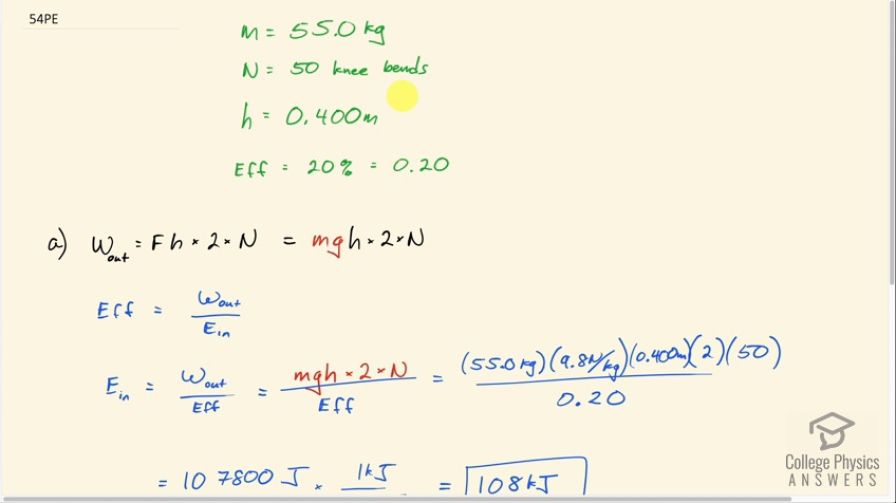Question
(a) Calculate the energy in kJ used by a 55.0-kg woman who does 50 deep knee bends in which her center of mass is lowered and raised 0.400 m. (She does work in both directions.) You may assume her efficiency is 20%. (b) What is the average power consumption rate in watts if she does this in 3.00 min?
Final Answer
Solution video
OpenStax College Physics for AP® Courses, Chapter 7, Problem 54 (Problems & Exercises)

vote with a rating of
votes with an average rating of
.
Calculator Screenshots
Video Transcript
This is College Physics Answers with Shaun Dychko. A woman with a mass of 55 kilograms does 50 knee bends and moves 0.400 meters in each direction— 0.400 meters down and then 0.400 meters up in one knee bend— and they do that with an efficiency of 20% which is 0.20 and we have to figure out what the energy consumption of this woman is. So the work output is the force that they are exerting multiplied by this height— this is the distance their knees bend— and multiply it by 2 because there's work being done in the downward direction and the upward direction because she is maintaining a constant speed in both directions. So while going down, she is exerting a force upwards to balance gravity and so that force upwards multiplied by that height is the work that she's doing on the way down. And then likewise going upwards, she's just balancing the weight in order to move upwards at constant speed. And we kind of ignore that sort of in-between period when she's at the bottom of her bend accelerating upwards we just ignore that part because that's well... difficult to account for and and it happens for only just a little tiny bit of distance and so it's negligible. Okay! So this is the work done in one direction and we multiply that by 2 because there are two directions for each knee bend so then we multiply that by the number of knee bends and this is the total work output and substituting mg in place of the force here. So we have mgh times 2 times N is the work output. The efficiency is this work output divided by the energy consumed, the energy input, and we rearrange for E in by multiplying both sides by E in divided by efficiency. So we have then the energy consumed is the work output divided by the efficiency so that's mgh times 2 times N over efficiency. That's 55.0 kilograms times 9.8 newtons per kilogram times 0.400 meters times 2 times 50 knee bends divided by 0.20—efficiency— which gives 108 kilojoules. The power consumption, the rate of energy input, is the energy input divided by the time. So that's 107800 joules consumed divided by 3 minutes converted into seconds by multiplying by 60 seconds per minute and we end up with 599 watts.
